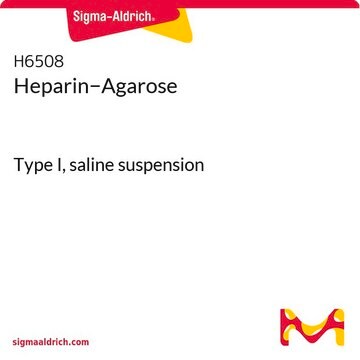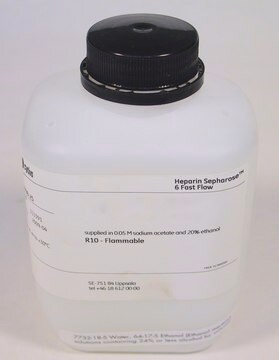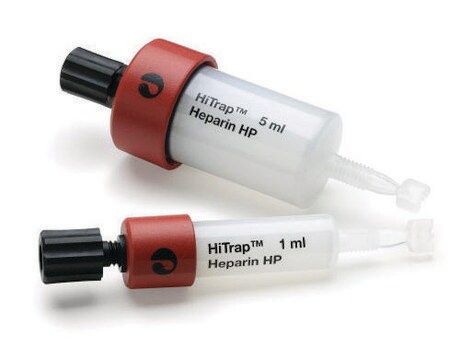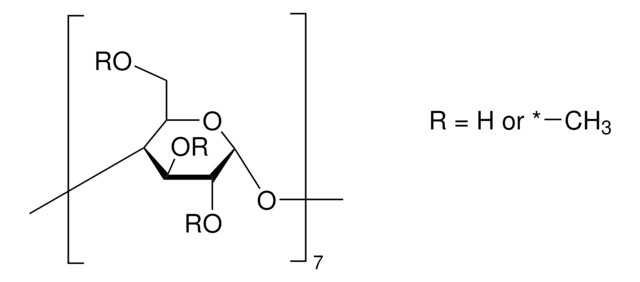H0402
Heparin−Agarose
(1:1 suspension in a 20% ethanol solution)
Autenticatiper visualizzare i prezzi riservati alla tua organizzazione & contrattuali
About This Item
Prodotti consigliati
Origine biologica
heparin from Porcine intestinal mucosa
Livello qualitativo
Stato
(1:1 suspension in a 20% ethanol solution)
Matrice
4% beaded agarose
Attivazione matrice
epichlorohydrin
Gruppi immobilizzati alla matrice
terminal aldehyde by reductive amination to amine linker
Braccio spaziatore
7 atoms
Capacità
≥0.5 mg/mL binding capacity (thrombin)
Temperatura di conservazione
2-8°C
Cerchi prodotti simili? Visita Guida al confronto tra prodotti
Applicazioni
Heparin agarose is developed from porcine intestinal mucosa and is used in affinity chromatography. Heparin agarose has been used in studies to provide information on human monocytic ehrlichiosis, tumor necrosis and the effects of coagulation from Vipera snake venom.
Stato fisico
1:1 suspension in a 20% ethanol solution
Nota sulla preparazione
Prepared by end-point attachment for high-efficiency fractionation of antithrombin III and other specific binding proteins
Avvertenze
Warning
Indicazioni di pericolo
Consigli di prudenza
Classi di pericolo
Flam. Liq. 3
Codice della classe di stoccaggio
3 - Flammable liquids
Classe di pericolosità dell'acqua (WGK)
WGK 3
Punto d’infiammabilità (°F)
104.0 °F - closed cup
Punto d’infiammabilità (°C)
40 °C - closed cup
Scegli una delle versioni più recenti:
Possiedi già questo prodotto?
I documenti relativi ai prodotti acquistati recentemente sono disponibili nell’Archivio dei documenti.
I clienti hanno visto anche
Kenji Kashiwagi et al.
Biomaterials, 30(6), 1166-1175 (2008-11-22)
Efficient immobilization of biomacromolecules on material surfaces is a key to development in areas of regenerative medicine and tissue engineering. However, strong and irreversible immobilization of cytokines on surfaces often diminishes their biological functionality. A destructive hydrophobic interaction between the
W H Yu et al.
The Journal of biological chemistry, 275(6), 4183-4191 (2000-02-08)
Many matrix metalloproteinases (MMPs) are tightly bound to tissues; matrilysin (MMP-7), although the smallest of the MMPs, is one of the most tightly bound. The most likely docking molecules for MMP-7 are heparan sulfate proteoglycans on or around epithelial cells
Glycosaminoglycan binding assays.
A J Hoogewerf et al.
Methods in molecular biology (Clifton, N.J.), 138, 173-177 (2000-06-07)
B A Kluszynski et al.
The Journal of biological chemistry, 272(21), 13541-13547 (1997-05-23)
We have studied the ability of histidine-rich glycoprotein (HRG) to neutralize the anticoagulant activity of heparin in plasma and in a purified component clotting assay. Addition of HRG to plasma or to the purified component assay did not neutralize the
Miriam Corredor et al.
Biophysical journal, 110(6), 1291-1303 (2016-03-31)
Semaphorin3A (Sema3A) is a vertebrate-secreted protein that was initially characterized as a repulsive-guidance cue. Semaphorins have crucial roles in several diseases; therefore, the development of Sema3A inhibitors is of therapeutic interest. Sema3A interacts with glycosaminoglycans (GAGs), presumably through its C-terminal
Il team dei nostri ricercatori vanta grande esperienza in tutte le aree della ricerca quali Life Science, scienza dei materiali, sintesi chimica, cromatografia, discipline analitiche, ecc..
Contatta l'Assistenza Tecnica.










